set.seed(1)16 Samples, populations estimates and their uncertainty
Scientific studies only occasionally gather all available data regarding some phenomena under study. All possible data are not available to us due to, e.g., practical or economic reasons. We, therefore, have no direct way of studying all elderly people’s responses to training or the relationship between strength and performance in all cyclists, etc. Thus, the scientist is faced with the challenge to draw conclusion about the world based on a limited set of observations.
All possible observations are often referred to as the population while the data set we have access to is called the sample. When we make claims about the population using a sample, we draw inference. Our ability to accurately draw inference (or conclusions) about the population based on our sample is determined by how we have gathered data. A sample is unbiased when it represents the population. Through random sampling from the population, we can be pretty sure that we, in most cases, have a representative sample free from bias. Bias may be a consequence of some systematic aspect of our sampling scheme, e.g., when studying healthy individuals’ responses to exercise, recruitment to the study may introduce bias as we are more likely to recruit participants who want to do exercise. Possibly, recruited individuals would respond differently compared to individuals not so willing to do exercise (see (Spiegelhalter 2019, Ch. 3).
We can characterize a sample using descriptive statistics. For example, a continuous variable such as V̇O2max can be described based on its central tendency (like the mean, \(\bar{y}\)) and variation (standard deviation, \(s_y\)). Such characteristics serves as a simple description of the sample and as estimates of characteristics of the population. These estimates can help us make claims about the population with a specified degree of certainty.
16.1 Reading instructions
Before going further, I suggest reading Chapters 7-10 in Spiegelhalter (Spiegelhalter 2019). These chapters are a great start for understanding the concepts discussed below.
16.2 Descriptive statistics in R
16.2.1 Simulating data in R
R is great because you can create data! In the examples below we will generate data, you can copy and paste the code into your R session to run it and answer questions in this lesson.
When we generate data in R we need to set the seed to make the random number generator create the same numbers every time. Basically, R generate numbers and if we want R to generate the same numbers every time we have to tell R where to start.
This means that before each simulation I will include:
The number within set.seed is important as it defines where R starts generating numbers.
16.3 A simple example
Let’s say that we collect data on V̇O2max values in trained cyclists (ml kg-1 min-1). We are interested in the average. First we simulate all possible values:
set.seed(1)
vo2max <- rnorm(100000, 70, 5)All possible values? Yes, we create a distribution of values of V̇O2max in trained cyclists based on the rnorm-function. rnorm simulates random numbers (100000 in this case) based on an average (in this case 75) and standard deviation (in this case 5). This population is now stored in the object vo2max.
We conduct our study and collect data on 20 participants. This represents only 2% of all possible numbers!
Below we use the sample function, this function draws a sample of a fixed size from our collection of random numbers. We store it in an object called samp
set.seed(1)
samp <- sample(vo2max, 20, replace = FALSE)replace = FALSE makes sure that we do not sample the same numbers more than once. This way our sampling resembles what an ideal real life study would do.
The samp object now contain numbers from a possible study. The study has recruited 20 randomly chosen cyclists and measured their V̇O2max. Let’s describe the sample.
In R we can describe the data using multiple methods, first we will calculate summary statistics.
m <- mean(samp)
s <- sd(samp)We can also use the summary function.
summary(samp) Min. 1st Qu. Median Mean 3rd Qu. Max.
58.91 65.10 69.88 69.19 74.28 80.36 Let’s make a graph of the sample. We can represent the sample using points across the range of values (Figure 16.1). Ou can use the code below to reproduce the figure.
Code
library(tidyverse) # Needed for making the plot!
df <- data.frame(samp = samp)
df %>%
# Plots our samples on the x axis, and sets all y to 1.
ggplot(aes(samp, y = 1)) +
# Adds points and "jitter" on the y axis
geom_point(position = position_jitter(height = 0.1)) +
# Scales the y axis to better plot the data
scale_y_continuous(limits = c(0,2)) +
# Set the name of the x axis
labs(x = "VO2max") +
# Add a theme
theme_classic() +
# The code below modifies the theme of the plot, removing
# the y axis
theme(axis.title.y = element_blank(),
axis.text.y = element_blank(),
axis.ticks.y = element_blank(),
axis.line.y = element_blank()) 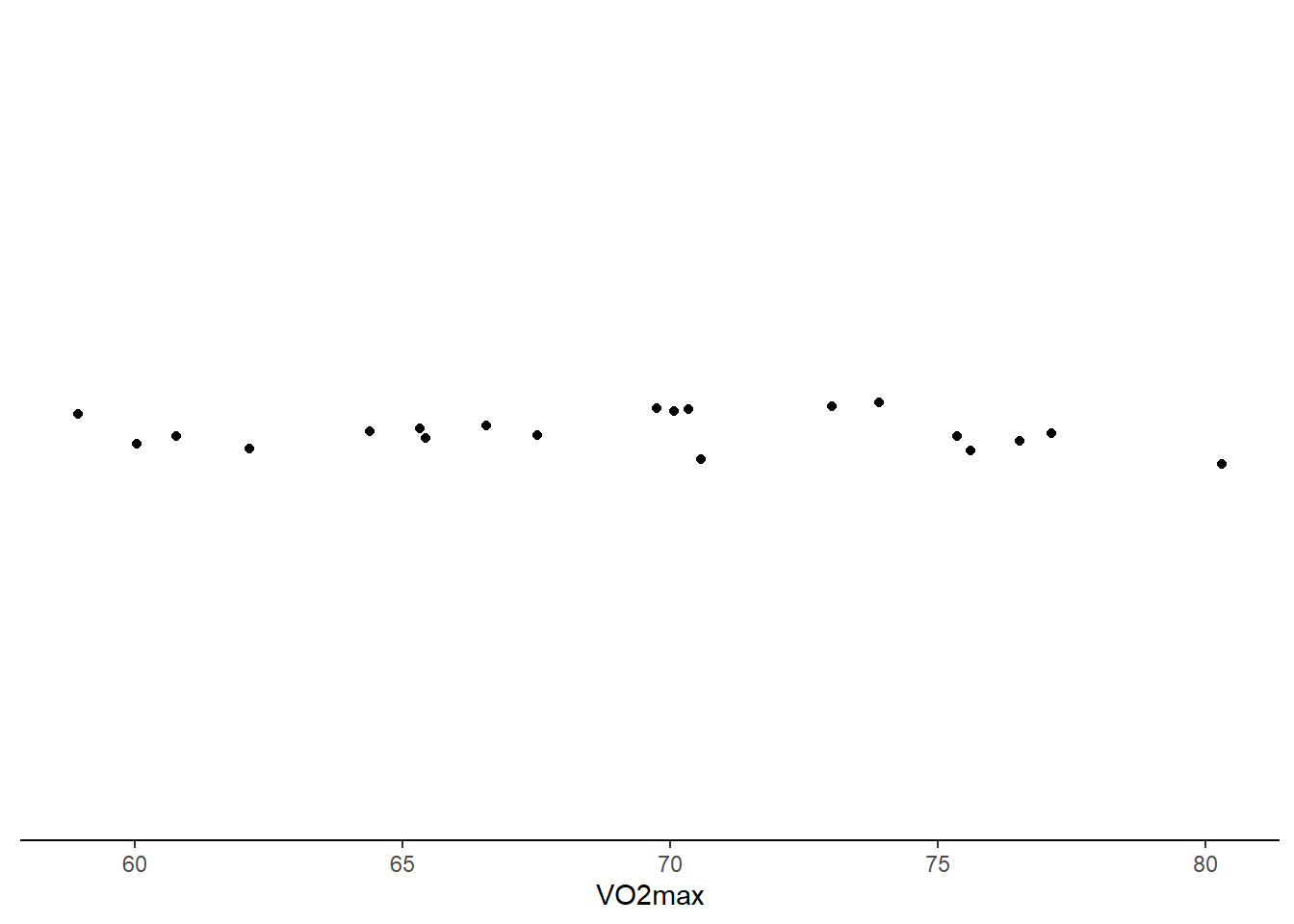
Another plot can be the box-plot (Figure 16.2), now also with a more precise axis label. Similarly to the above plot you can reproduce our new figure with the code below.
Code
# ggtext must be installed to create the appropriate axis label
library(ggtext)
df %>%
# Plots our samples on the y axis, and sets all x to 1.
ggplot(aes(x = 1, samp)) +
# Adds the boxplot
geom_boxplot(width = 0.5) +
# Scales the x axis to better plot the data
scale_x_continuous(limits = c(0,2)) +
# Set the name of the y axis
labs(y = "V̇O~2max~ (ml kg<sup>-1</sup> min<sup>-1</sup>)") +
theme_classic() +
# The code below modifies the theme of the plot, removing
# the x axis
theme(axis.title.x = element_blank(),
axis.text.x = element_blank(),
axis.ticks.x = element_blank(),
axis.line.x = element_blank(),
axis.title.y =element_markdown())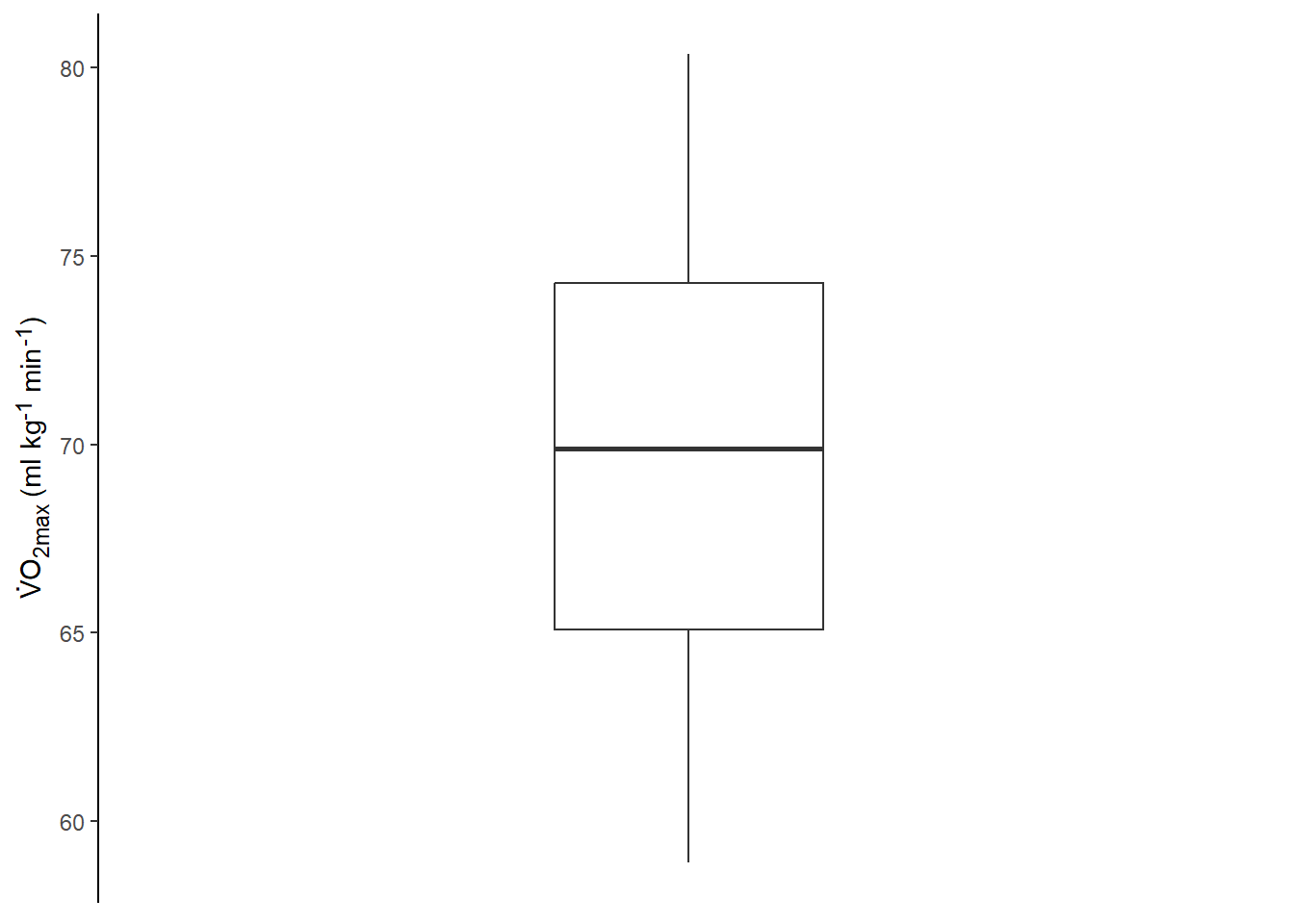
The boxplot (or box-and-whiskers plot (Spiegelhalter 2019, Ch. 2)) summarizes the data and plots the median, the inter-quartile range minimum and maximum, and any outliers.
We can also plot the data as a histogram (Figure 16.3).
Code
df %>%
# Plots our samples on the y axis, and sets all x to 1.
ggplot(aes(samp)) +
# Adds the histogram
geom_histogram(binwidth = 3, color = "blue", fill = "lightblue") +
# Set the name of the y axis
labs(x = "V̇O~2max~ (ml kg<sup>-1</sup> min<sup>-1</sup>)", y = "Count") +
theme_classic() +
# The code below modifies the theme of the plot, removing
# the x axis
theme(axis.title.x =element_markdown())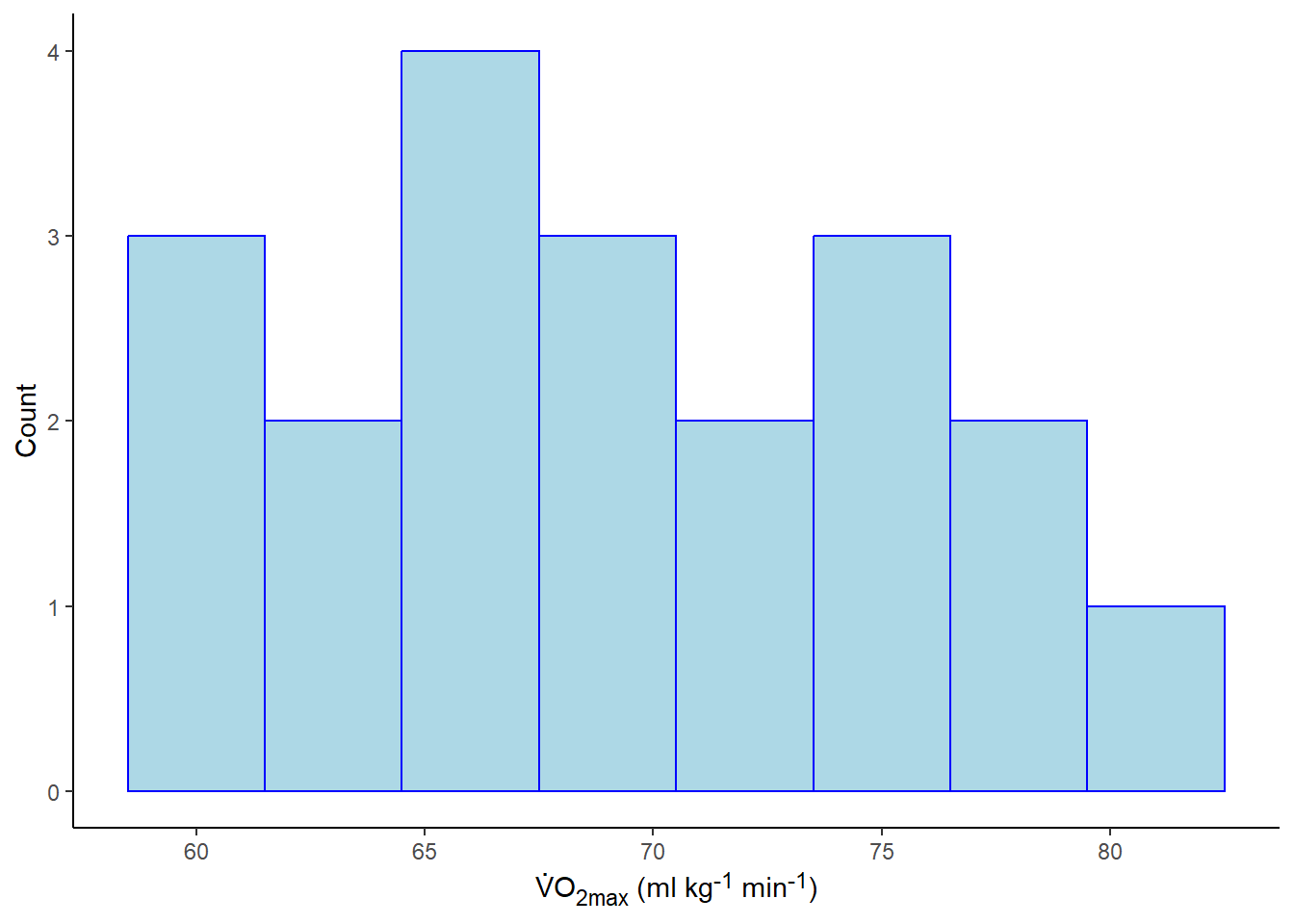
Both the statistical summaries (created with mean, sd and summary) and the plots are descriptive analyses of the sample. We still have not made any claims about the population.
16.4 Inference about the population
When doing a study, we are really interested in what we can say about the population (all possible values). In other words, how we can draw conclusions about the unknown, based on our data. This is were inferential statistics comes in.
As we have an estimate of the mean in the population, we may say that based on our sample we believe the mean is close to mean(samp). It is very likely that the mean in the population is not exactly that. Let’s try another sample:
set.seed(2)
samp2 <- sample(vo2max, 20, replace = FALSE)
# Calculate the mean
m2 <- mean(samp2)
c(m, m2)[1] 69.19015 71.12632As we can see there is going to be some differences due to the fact that every time we draw a new sample (or conduct another study), we will get a slightly different estimate of the mean. How about the variation:
s2 <- sd(samp2)
# Print the results from calculation of SD
c(s, s2)[1] 6.210114 6.158459Indeed, slightly different.
We could continue to sample in this way and record every outcome to build a distribution of means. A convenient way to do this is to create a for-loop. This is a basic building block in programming, we tell the computer to do a task multiple times and store the results in a nice format. We will sample with size = 20 and calculate the mean in each loop. The results will be stored in a data frame.
# set the seed
set.seed(123)
# create the data frame
results <- data.frame(mean = rep(NA, 1000))
# The rep function creates a vector full of NA
# each NA can be replaced with a mean
# Second we build the for loop
for(i in 1:1000){
results[i, 1] <- mean(sample(x = vo2max, size = 20, replace = FALSE))
}The results from this process can made into a figure. We will use the histogram to represent the distribution of sample means from our repeated samples.
Code
ggplot(data = results, aes(mean)) +
geom_histogram(fill = "lightblue", color = "gray40", binwidth = 1) +
labs(x = "Sample averages of V̇O~2max~ (ml kg<sup>-1</sup> min<sup>-1</sup>)", y = "Count") +
theme_classic() +
theme(axis.title.x = element_markdown())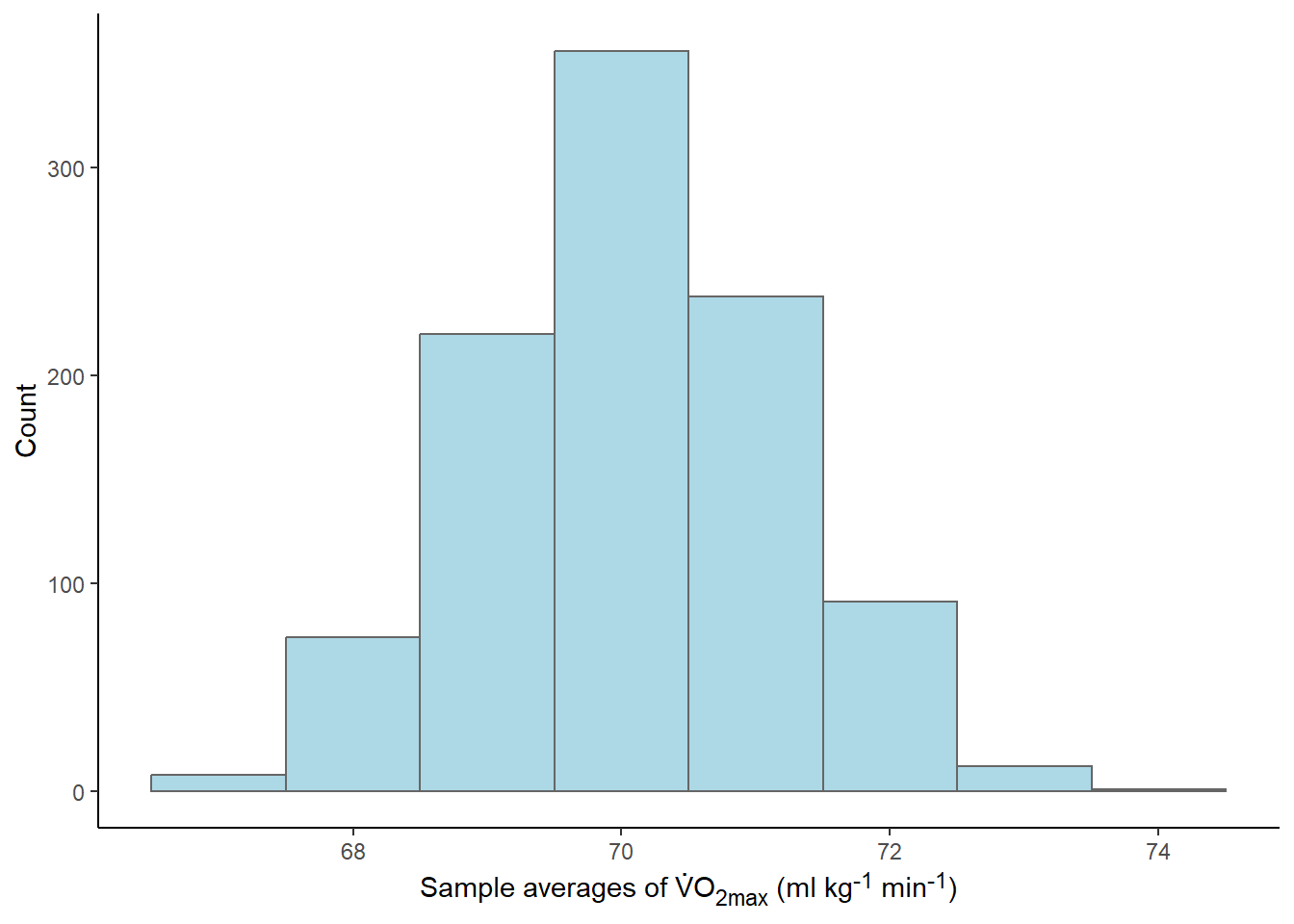
What did just happened? We basically conducted 1000 studies, from each study we calculated the mean and stored them. Most of the means were very close to 70 as we can see in the graph. The distribution of the means is bell-shaped, actually the distribution looks like something that we can call a Normal distribution.
Distributions can be described in different ways depending on what distribution we are takling about. The most commonly used, the normal (or Gaussian) distribution can be described by the mean and the standard deviation.
As the distribution of means is approximately normal we can determine where most of the means are. Let’s say that we are interested in determining a range where 95% of the means can be found. To do this we can use a theoretical distribution created by estimates from the distribution (the mean and standard deviation).

95% of all means are under the shaded area! This corresponds to a range of values that can be calculated in R:
lower <- mean(results[,1]) - 1.96 * sd(results[,1])
upper <- mean(results[,1]) + 1.96 * sd(results[,1])What does this mean? Well, we have drawn 1000 samples from our bag of numbers (representing all possible outcomes). We then calculated the mean of each sample and created a distribution of means. The mean of means is very, very close to the true (population) mean.
Code
cat(paste("True mean:",
round(mean(vo2max),2),
"\nMean of the sample distribution: ",
round(mean(results[,1]),2)))True mean: 69.99
Mean of the sample distribution: 70.06We have also calculated a range were 95% of all means are located, we did this by approximating the actual values using the normal distribution. The range that captures 95% of all means goes from 67.88 to 72.23
16.5 Estimation of the sampling distribution
What we have done above is a very theoretical example as we never do 1000 studies in real life. We will never get a distribution of means from many studies. However we can estimate this theoretical distribution of means using a sample!
This is one of the most important concepts in statistics! This means that by doing one study we can estimate the results of doing many studies. This is the basis of frequentist statistics.
16.5.0.1 The standard error of a sample is an approximation of the standard deviation of the sampling distribution
The headline says it all. Basically, using the sample we can calculate the standard deviation, the standard deviation in turn can be used to calculate the standard error. The standard error is an estimate of the standard deviation of the theoretical distribution of means. Let’s see how it works out!
Using R we can simulate this concept. We will create a new set of random samples (or studies) and calculate statistics from them. The results from this simulation can be seen in Figure 16.6.
Code
library(cowplot) # to combine plots
# set the seed
set.seed(9)
# create the data frame
results <- data.frame(mean = rep(NA, 5000),
sd = rep(NA, 5000))
# The rep function creates a vector full of NA
# each NA can be replaced with a mean
# Second we build the for loop
for(i in 1:5000){
samp <- sample(x = vo2max, size = 20, replace = FALSE)
results[i, 1] <- mean(samp)
results[i, 2] <- sd(samp)
}
results <- results %>%
# Calculate the standard error of each sample
mutate(se = sd/sqrt(20))
# Plot the sample averages in a histogram
#
#
p1 <- results %>%
slice_head(n = 1000) %>% # select the first 1000 rows
# Make a graph containing estimates and empirical values
ggplot(aes(mean)) + geom_histogram(binwidth = 0.5,
fill = "steelblue",
color = "black") +
theme_classic() +
# Add a line representing the standard deviation of the distribution of means
annotate(geom = "segment",
y = c(220, 220, 220),
yend = c(212, 220, 212),
x = c(mean(results$mean), mean(results$mean), mean(results$mean) + sd(results$mean)),
xend = c(mean(results$mean), mean(results$mean) + sd(results$mean), mean(results$mean) + sd(results$mean)),
lty = 1,
color = "navy",
size = 1) +
# Add text to describe SD of sampling distribution
annotate(geom = "text",
x = mean(results$mean),
y = 235,
hjust = 0,
label = paste0("SD = ",
round(sd(results$mean), 2))) +
coord_cartesian(ylim = c(0, 280)) +
labs(x = "Sample averages",
y = "Number of samples")
# Create a plot of calculated SE
p2 <- results %>%
slice_head(n = 1000) %>% # select the first 1000 rows
ggplot(aes(se)) + geom_histogram(binwidth = 0.08,
fill = "steelblue",
color = "black") +
theme_classic() +
# Add text to describe SD of sampling distribution
annotate(geom = "text",
x = mean(results$se),
y = 235,
hjust = 0,
label = paste0("Average SE = ",
round(mean(results$se), 2))) +
coord_cartesian(ylim = c(0, 280)) +
labs(x = "Sample Standard Errors",
y = "Number of samples")
plot_grid(p1, p2, ncol = 2)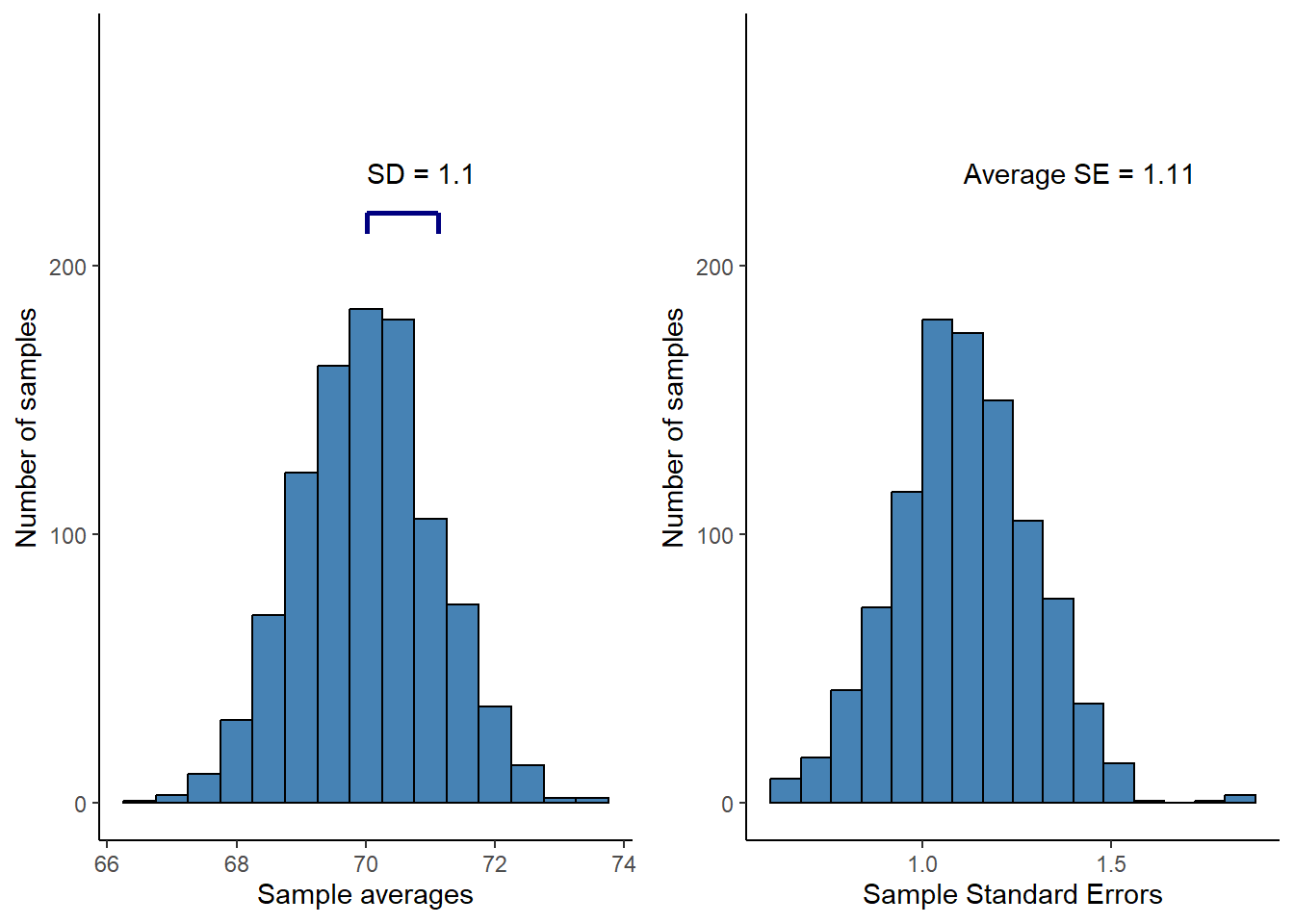
In the left panel of Figure 16.6, the blue line represents the standard deviation of the distribution of the sample mean. In the right panel we can see the resulting distribution of standard errors from all the samples. The variation (spread) of the sampling distribution corresponds to the long run average of the standard error calculated in each sample. On average, the standard error of the mean is a pretty good estimate of the variation in the distributions of means. The standard error (SE) of the mean is calculated as:
\[\operatorname{SE} = \frac{s}{\sqrt{n}}\] where \(s\) is the sample standard deviation, \(n\) is the number of observations.
Remember that we can use the standard deviation to calculate a range of values containing, let’s say, 95% of all values in a normal distribution. As we have a way of estimating the standard deviation of the sampling distribution of averages, we can do this by using a single sample. When estimating this range using a sample we create a confidence interval!
16.5.1 A confidence interval for the mean
A confidence interval for the mean based on a sample can be calculated as:
\[\text{Lower limit}=\operatorname{Mean} - 1.96 \times \operatorname{SE}\] \[\text{Upper limit}=\operatorname{Mean} + 1.96 \times \operatorname{SE}\]
(This assumes that we are using the normal distribution).
The interpretation of the confidence interval is that 95% of confidence intervals, created using repeated sampling will contain the population mean. But unfortunately, we do not know if our specific interval do so.
The interpretation follows from the fact that we estimate the variation in the theoretical sampling distribution. Five percent of the time we will be wrong.
To test if the theory is correct, lets calculate confidence intervals from our simulated data and see how many times we catch the true mean.
Code
# Create new variables with upper and lower limits of the confidence interval
cis <- results %>%
# Using the normal distribution
mutate(lower.limit = mean - 1.96 * sd/sqrt(20),
upper.limit = mean + 1.96 * sd/sqrt(20)) %>%
# Test if the true mean is within the limits
# If the true mean is above the lower limit and below the upper limit then TRUE
# otherwise FALSE
mutate(true.mean = if_else(mean(vo2max) > lower.limit & mean(vo2max) < upper.limit,
TRUE, FALSE))
# Plot the data, only plotting 200 data points to make it suitable for every computer
cis[1:200, ] %>%
ggplot(aes(seq(1:nrow(.)),
y = mean,
color = true.mean, # set a specific color
alpha = true.mean)) + # and transparency to
# intervals containing and not containing the true mean
# add a line showing the true mean
geom_hline(yintercept = mean(vo2max)) +
# add errorbars showing each interval
geom_errorbar(aes(ymin = lower.limit, ymax = upper.limit)) +
# scale the colors and transparency. Intervals not containing
# the true mean are red.
scale_color_manual(values = c("red", "black")) +
scale_alpha_manual(values = c(1, 0.2)) +
# Set label texts
labs(x = "Sample",
y = "Mean",
alpha = "Contains\nthe true mean",
color = "Contains\nthe true mean") +
# Change the theme
theme_classic()
# Calculate the proportions of intervals not containing the true mean
longrun <- round(100 * (sum(cis$true.mean == FALSE) / sum(cis$true.mean == TRUE)), 2)
# Almost 5%!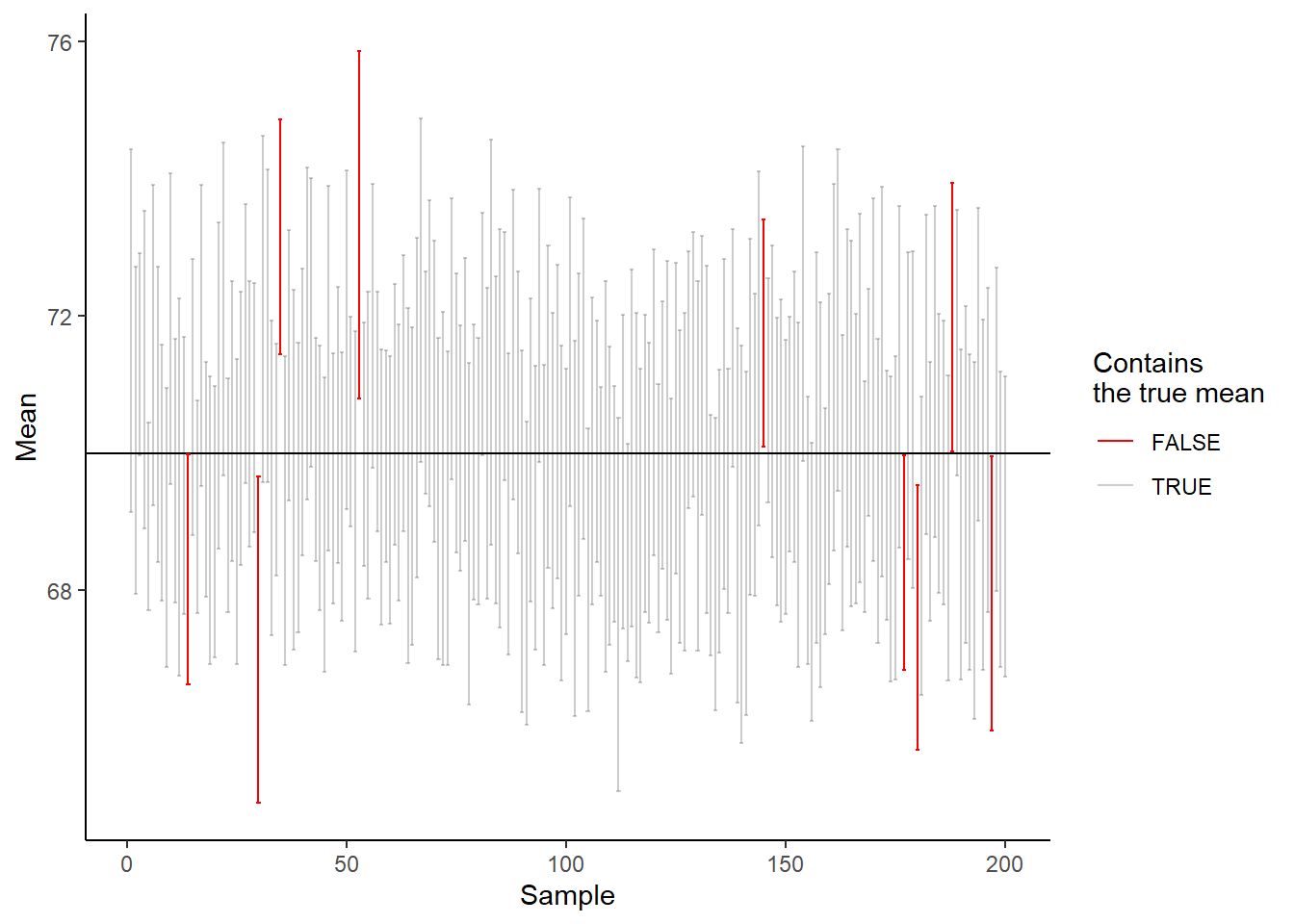
As we can see in Figure 16.7, we are really close to the expected 5%, our result is actually 5.89%. This means that if we do a study 1000 times and calculate the average and its confidence interval, in about 5% of the studies we will be missing the true mean. Seen from the other side, about 95% of the times, our interval will contain the true mean.
But why isn’t the result precisely 5%? It is due to the fact that the normal distribution is not a calibrated distribution to use for the approximation of a sampling distribution when sample sizes are low. We can instead use the t-distribution. (This distribution has something to do with beer!)

The t-distribution changes its shape depending on how many data points we have in our sample. This means that a smaller sample size will be reflected in the estimated sampling distribution through a wider interval. In the code and plot (Figure 16.8) below we have changed the calculation of the 95% confidence interval, we are using the t-distribution instead.
Code
# Creat new variables with upper and lower limits of the confidence interval
cis <- results %>%
# Using the t-distribution
mutate(lower.limit = mean - qt(0.975, 20-1) * sd/sqrt(20),
upper.limit = mean + qt(0.975, 20-1) * sd/sqrt(20)) %>%
# Test if the true mean is within the limits
# If the true mean is above the lower limit and below the upper limit then TRUE
# otherwise FALSE
mutate(true.mean = if_else(mean(vo2max) > lower.limit & mean(vo2max) < upper.limit,
TRUE, FALSE))
# Plot the data, only plotting 100 data points to make it suitable for every computer
cis[201:400, ] %>%
ggplot(aes(seq(1:nrow(.)),
y = mean,
color = true.mean, # set a specific color
alpha = true.mean)) + # and transparency to
# intervals containing and not containing the true mean
# add a line showing the true mean
geom_hline(yintercept = mean(vo2max)) +
# add errorbars showing each interval
geom_errorbar(aes(ymin = lower.limit, ymax = upper.limit)) +
# scale the colors and transparency. Intervals not containing
# the true mean are red.
scale_color_manual(values = c("red", "black")) +
scale_alpha_manual(values = c(1, 0.2)) +
# Set label texts
labs(x = "Sample",
y = "Mean",
alpha = "Contains\nthe true mean",
color = "Contains\nthe true mean") +
# Change the theme
theme_classic()
# Calculate the proportions of intervals not containing the true mean
longrun <- round(100 * (sum(cis$true.mean == FALSE) / sum(cis$true.mean == TRUE)), 2)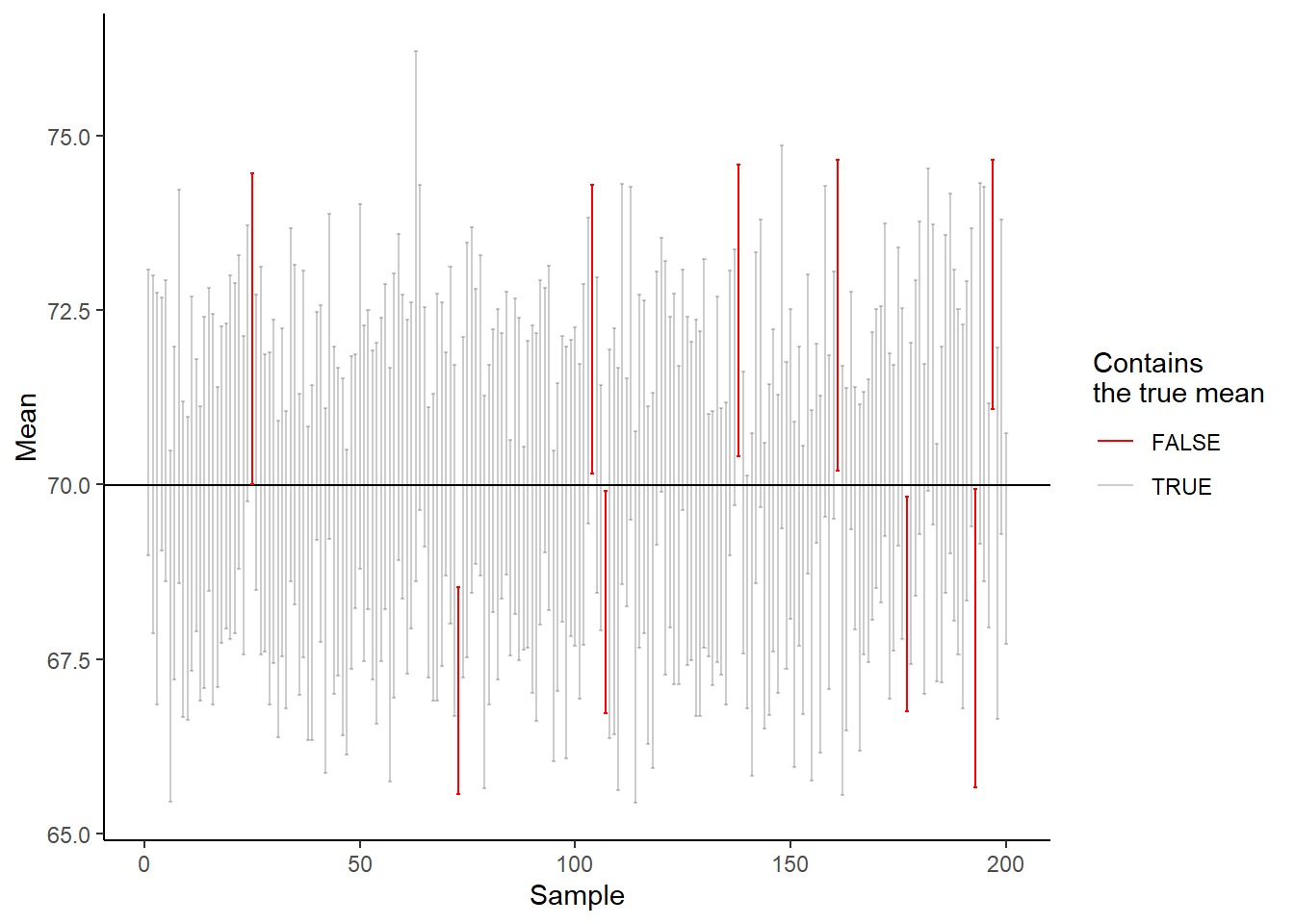
We are getting closer, from 5000 simulations of sampling from a population and creation of 95% confidence intervals based on the t-distribution we end up with 95.53% of confidence intervals containing the true population mean. The t-distribution is better calibrated for samples that are small. The two distributions (normal and t) are very similar when we are getting closer to sample sizes of \(n=30\).
16.5.2 Sample size and confidence intervals
The width of confidence intervals are determined by the mean, standard deviation and the sample size. If the sample size gets lower the width will increase. This means that when we have smaller samples will have less precision in our best guess of the population mean. We will still cover the true mean 95% of the time (if we repeat our study) but the range of possible values of the true mean will be wider.
16.6 Sampling distribution of IQ
IQ values are normally distributed with median 100 (since the distribution is normal, this should be very close the the mean) and standard deviation of 15. Using a sample from the population we can calculate a 95% confidence interval. We will do this with n=5, n=25 and n=100. You will have to execute the code. A 95% confidence interval based on the t-distribution can be calculated as:
Code
# set the seed
set.seed(1)
# A population of numbers
pop <- rnorm(100000, mean = 100, sd = 15)
# Sampling from the distribution
n5 <- sample(pop, 5, replace = FALSE)
n25 <- sample(pop, 25, replace = FALSE)
n100 <- sample(pop, 100, replace = FALSE)
# n = 10
mean_n5 <- mean(n5)
s_n5 <- sd(n5)
error_n5 <- qt(0.975, df = 5-1) * s_n5/sqrt(5)
# n = 25
mean_n25 <- mean(n25)
s_n25 <- sd(n25)
error_n25 <- qt(0.975, df = 25-1) * s_n25/sqrt(25)
# n = 100
mean_n100 <- mean(n100)
s_n100 <- sd(n100)
error_n100 <- qt(0.975, df = 100-1) * s_n100/sqrt(100)Above we used the qt function to get the quantile corresponding to a 95% confidence interval. By running the function with qt(0.975, df = 100-1), and qt(0.975, df = 25-1) we can see that a smaller sample affects the t-distribution. Test what the result is if you only run qnorm(0.975).
We can collect the pieces and create a plot using the code below:
Code
df <- data.frame(sample.size = c(5, 25, 100),
mean = c(mean_n5, mean_n25, mean_n100),
error = c(error_n5, error_n25, error_n100))
df %>%
ggplot(aes(as.factor(sample.size), mean)) +
geom_errorbar(aes(ymin = mean-error, ymax = mean + error), width = 0.2) +
geom_point(size = 3) +
theme_classic()What can you say about the effect of sample size on the confidence of an estimate?
16.7 A hypothesis test
We know that a random sample will have a mean close to the centre of the population distribution (100 in the case above). We want to know if chess players (\(\text{Chess}\)) have higher IQ scores than average people (\(\text{Average}\)). We can create an alternative hypothesis stating that
\[\operatorname{H_A}: \text{Chess} \neq \text{Average}\]
The null hypothesis that we are comparing to is
\[\operatorname{H_0}: \text{Chess} = \text{Average}\]
We collect data from chess players (\(n=24\)). Use the data below to test \(\operatorname{H_0}\).
| Chess player | IQ |
|---|---|
| 1 | 129 |
| 2 | 101 |
| 3 | 98 |
| 4 | 89 |
| 5 | 103 |
| 6 | 107 |
| 7 | 123 |
| 8 | 117 |
| 9 | 114 |
| 10 | 109 |
| 11 | 110 |
| 12 | 99 |
| 13 | 101 |
| 14 | 102 |
| 15 | 130 |
| 16 | 121 |
| 17 | 129 |
| 18 | 115 |
| 19 | 107 |
| 20 | 109 |
| 21 | 107 |
| 22 | 96 |
| 23 | 98 |
| 24 | 102 |
Try to calculate the sample average and a confidence interval and answer these questions:
- What is the average IQ among chess players?
- What is your best guess about the population average of chess players?
- What does the confidence interval say about your hypothesis?
Here is a possible solution
chess.players <- c(129, 101,98 ,89 ,103,107,123,117,114,
109,110,99 ,101,102,130,121,129,115,
107,109,107,96 ,98,102)
chess.mean <- mean(chess.players)
chess.error <- qt(0.975, df = 24-1) * sd(chess.players)/sqrt(24)
c(chess.mean - chess.error, chess.mean + chess.error)16.8 Using a confidence interval when planning a study
We can calculate the mean change from pre- to post-training in the cycling study for V̇O2max.
For this exercise, use the cyclingstudy data set, you will find it in the exscidata package. The variables of interest are subject, group, timepoint and VO2.max. In the time-point variable, meso3 are the post-training values and pre are the pre-training values.
Calculate the mean change in absolute units (ml min-1) of V̇O2max for the whole data set together with the sample SD. Then calculate a confidence interval.
How do you interpret the confidence interval?
Here is a possible solution
library(tidyverse); library(exscidata)
data("cyclingstudy")
cyclingstudy %>%
select(subject, group, timepoint, VO2.max) %>%
filter(timepoint %in% c("pre", "meso3")) %>%
pivot_wider(names_from = timepoint, values_from = VO2.max) %>%
mutate(change = meso3-pre) %>%
group_by() %>%
summarise(m = mean(change, na.rm = TRUE),
s = sd(change, na.rm = TRUE),
n = sum(!is.na(change)),
error = qt(0.975, df = n -1) * s/sqrt(n),
lower = m - error,
upper = m + error) %>%
print()The confidence interval can be interpreted as: in 95% percent of confidence intervals created from repeated sampling we will have the true mean. The confidence interval we have created does not contain 0.
Let’s say that we are designing a new study. We want to be able to show a difference between pre- to post-training in V̇O2max of 100 ml min-1 as this might be an important difference. Given the standard deviation that you have calculated above, how many participants should be recruit to the study to be able to detect a difference of 100 ml min-1 and at the same time exclude the null-hypothesis that says that the true population average is 0.
Here you can try to calculate the lower limit of a 95% confidence interval given a standard deviation equal to what you calculated above and a mean change of interest of 100 ml min-1 using many different alternatives for the sample size.
A possible solution
## Calculate sd
s <- cyclingstudy %>%
select(subject, group, timepoint, VO2.max) %>%
filter(timepoint %in% c("pre", "meso3")) %>%
pivot_wider(names_from = timepoint, values_from = VO2.max) %>%
mutate(change = meso3-pre) %>%
group_by() %>%
summarise(s = sd(change, na.rm = TRUE)) %>%
pull(s)
# Create a figure of lower limit of a confidence interval
#
data.frame(s = s) %>% # Add SD to a data frame and expand
# the data frame with a sequence of sample sizes
expand_grid(n = seq(from = 10, to = 100, by = 2)) %>%
# Calculate the error using a t-distribution for the sequence
# of sample sizes. Calculate the lower bound of a 95% confidence
# interval as the mean of interest (100) - the error.
mutate(error = qt(0.975, df = n - 1) * s / sqrt(n),
cil = 100 - error) %>%
# Plot the results.
ggplot(aes(n, cil)) +
geom_point() +
geom_hline(yintercept = 0)Try to answer the following questions:
- How could the above information help you when designing a study?
- Why is there a relationship between sample size and the lower bound of the confidence interval?
When designing a study we state an alternative hypothesis, in the above case we use 100 ml min-1. We ask, if the alternative hypothesis is true and a new study also arrives at a similar variation in the outcome (SD), how many participants do we need to recruit to disprove the null-hypothesis? The graph indicates that we need > 25 participants.
The confidence interval is affected by sample size in two ways. First we use the standard error to calculate the error (\(\operatorname{SE}=s/\sqrt{n}\)). As this quantity will become larger when n is smaller we will have less precision with small n. Also, the t-distribution is wider (heavier tails) with small n.